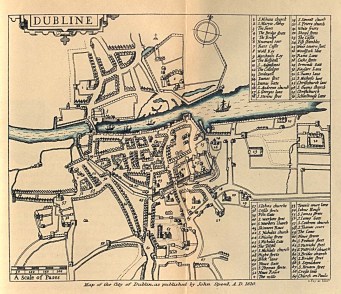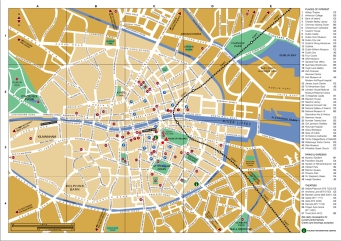Dublin was stagnant until the 17 century when profound political and religious change in Britain had consequences on the city. Dublin began to expand as its power was asserted through parliaments and courts and its prosperity in trade. The first map of Dublin is by John Speed created in 1610 (http://www.lib.utexas.edu/maps/historical/dublin_1610_1896.jpg) . This map portrays a simpler Dublin than the capital we are familiar with today. The city is expanding from both sides of the River Liffey with the buildings taking on a linear pattern as they moved outwards and forming in clusters near the river itself. There are plenty of churches located on this map such as St.Stevens church (19) and S.Owens Church (34) to name but a few. The feature of so many churches shows that religion played a strong part in the lives of the locals. Open spaces can be found as you move out from the centre of the city and they are surrounded by a few buildings which suggests that they could be farms. This is evidence of an agricultural society in Dublin. There are also four ships visible along the River Liffey which shows that the river was used for a mode of transport and also trade.
http://www.lib.utexas.edu/maps/historical/dublin_1610_1896.jpg
http://www.guidetodublin.com/images/dubmap.jpg
Today’s map of Dublin shows a more complex Dublin than the one in 1610. This (http://www.guidetodublin.com/images/dubmap.jpg) shows that the city has had to cope with the ever expanding population through the creation of new roads, streets, motorways and transport systems such as the dart line. Due to the expanding population the city has had to grow further into the suburbs in order to accommodate the growing economy. There are still some green areas present but they take the form of parks such as Phoenix Park and St.Stephens Green. Churches are also visible in this map but to a lesser extent than in 1610. Dublin as our capital city is a major centre of trade, jobs and education and with so many people competing for a place in their economy the city will continue to grow into the suburbs and this will continue the need for modernity. Holly Hogan 110319125

Dublin Port in the 1800s
http://www.theirishstory.com/2012/06/04/making-money-in-dublin-1500-2000/#.UJhHGsWl7LU (05/11/12)

Dublin Port Today
http://www.johnhennessy.co.uk/photoGallery_pages/eireAthCliath_arranQuay
(05/11/12)


